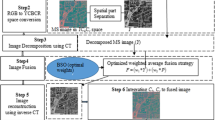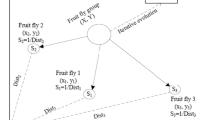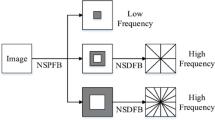Abstract
Nowadays, optimization has become a brand methodology for different applications. One of the most promising fields for application of optimization is the image processing field, especially image fusion. A new effective deterministic optimization technique is the modified central force optimization (MCFO) that overcomes the low convergence rate drawback of the central force optimization (CFO). In this paper, the MCFO is applied with standard image fusion methods as a novel brand to improve the fusion efficiency either qualitatively or quantitatively. Intensity-hue-saturation (IHS), high-pass filtering (HPF), and discrete wavelet transform (DWT) are powerful standard techniques for satellite image fusion that are implemented with MCFO optimization in this paper. They are performed on satellite panchromatic (PAN) and multispectral (MS) images. The target of using the MCFO is to reduce some spectral and spatial distortions that may occur without optimization. Different qualitative indices have been used to validate the proposed approach comprising optimization for satellite image fusion.











Similar content being viewed by others
References
Aiazzi B, Alparone L, Baronti S, Garzelli A (2002) Context-driven fusion of high spatial and spectral resolution images based on oversampled multi-resolution analysis. IEEE Trans Geosci Remote Sens 40(10):2300–2312
Aiazzi B, Baronti S, Selva M (2007) Improving component substitution pan-sharpening through multivariate regression of MS+Pan Data. IEEE Trans Geosci Remote Sens 45(10)
Amarsaikhan D, Saandar M (2011) Fusion of multisource images for update of urban GIS. In: Image Fusion and Its Applications book, ch.8, pp 127–152
Bick M (2015) Central force optimization - analysis of data structures & multiplicity factor. M.Sc. Thesis, University of Toledo
El-Hoseny HM, Abd El-Rahman W, El-Rabaie EM, El-Samie FEA, Faragallah OS (2018) An efficient DT-CWT medical image fusion system based on modified central force optimization and histogram matching. Journal of Infrared Physics and Technology 94:223–231
Formato RA (2007) Central force optimization: a new metahuristic with applications in applied electromagnetics. Prog Electromagn Res 77:425–491
Formato RA (2010) Parameter-free deterministic global search with simplified central force optimization. Springer-Verlag, Berlin Heidelberg, pp 309–318
Ghassemian H (2016) A review of remote sensing image fusion methods. Journal of Information Fusion 32(part A):75–89
Guang Z, Zhao Z, Gao Q, Wang S (2011) Infrared and visible images fusion based on contourlet-domain Hidden Markov Tree model. In: International Congress on Image and Signal Processing (ICISP), pp 1916–1920
Han SS, Li HT, Gu HY (2008) The study on image fusion for high spatial resolution remote sensing images. In: The International Archives of the Photogrammetry, Remote Sensing and Spatial Information Sciences. vol. XXXVII. part B7, pp. 1159–1164, Beijing
Jagalingam P (2015) ArkalVittalHegde, "a review of quality metrics for fused image". Aquatic Procedia 4:133–142
Ji Q, Zhao H (2016) A novel visible image fusion algorithm based on downsampling fractional wavelet transform and shearlet transform. In: International Conference on Communication and Electronics Systems (ICCES), pp 1–5
Lan X, Ma AJ, Yuen PC (2014) Multi-cue visual tracking using robust feature-level fusion based on joint sparse representation. In: IEEE Conference on Computer Vision and Pattern Recognition (CVPR), pp 1194–1201
Lan X, Ma AJ, Yuen PC, Chellappa R (2015) Joint sparse representation and robust feature-level fusion for multi-Cue visual tracking. IEEE Trans Image Process 24(12):5826–5841
Lan X, Zhang S, Yuen PC (2016) Robust joint discriminative feature learning for visual tracking. In: International joint conference on artificial intelligence (IJCAI), pp 3403–3410
Lan X, Zhang S, Yuen PC, Chellappa R (2018) Learning common and feature-specific patterns: a novel multiple-sparse-representation-based tracker. IEEE Trans Image Process 27(4):2022–2037
Lan X, Ye M, Zhang S, Yuen PC (2018) Robust collaborative discriminative learning for RGB-infrared tracking. In: AAAI Conference on Artificial Intelligence (AAAI), pp 7008–7015
Lee DTL, Yamamoto A (1994) Wavelet analysis: theory and applications. Hewlett-Packard Journal 45:44–54
Leng L, Zhang J, Xu J, Khan MK, Alghathbar K (2010) Dynamic weighted discrimination power analysis in DCT domain for face and palmprint recognition. In: International Conference on Information and Communication Technology Convergence (ICTC), pp 467–471
Leng L, Zhang J, Khan MK, Chen X, Alghathbar K (2010) Dynamic weighted discrimination power analysis: a novel approach for face and palmprint recognition in DCT domain. International Journal of the Physical Sciences 5(17):2543–2554
Leng L, Zhang J, Chen G, Khan MK, Alghathbar K (2011) Two-directional two-dimensional random projection and its variations for face and palmprint recognition. In: International Conference on Computational Science and Its Applications (ICCSA), pp 458–470
Leng L, Zhang S, Bi X, Khan MK (2012) Two-dimensional cancelable biometric scheme. In: International conference on wavelet analysis and pattern recognition (ICWAPR), pp 164–169
Liu H, Zhang X (2009) Comparison of data fusion techniques for Beijing-1 micro-satellite images. In: Urban Remote Sensing Joint Event. IEEE
Mahdinejad N, Mota HO, Silva EJ, Adriano R (2017) Improvement of system quality in a generalized finite-element method using the discrete curvelet transform. IEEE Trans Magn 53(6)
Mahmoud KR (2016) Synthesis of unequally-spaced linear array using modified central force optimization algorithm. IET Microwaves, Antennas & Propagation 10(10):1011–1021
Metwalli MR (2012) Assessing the quality of satellite images using advanced data fusion techniques. Ph.D. thesis in Electronic Engineering, Menofia University, Egypt
Mitchell HB (2010) Image fusion: theories, techniques and applications. Springer-Verlag, Berlin Heidelberg, e-ISBN 978–3–642-11216-4
Murino V, Trucco A, Regazzoni CS (1996) Synthesis of unequally spaced arrays by simulated annealing. IEEE Trans Signal Process 44(1):119–123
Naidu VPS (Jan. 2012) Discrete cosine transform based image fusion techniques. Journal of Communication, Navigation and Signal Processing 1(1):35–45
Nanbo J, Rahmat SY (2007) Advances in particle swarm optimization for antenna designs: Real-number, binary, single-objective and multi-objective implementations. IEEE Trans Antennas Propag 55(3):556–567
Pandit VR, Bhiwani RJ (2015) Image fusion in remote sensing applications: a review. Int J Comput Appl 120(10)
Rajo IE, Quevedo TO (2007) Linear array synthesis using an ant-colony-optimization-based algorithm. IEEE Antennas Propag Mag 49(2):70–79
Raut GN, Paikrao PL, Chaudhari DS (2013) A study of quality assessment techniques for fused images. IJITEE 2(4)
Rojas R (1996) Neural networks. Springer-Verlag, Berlin, ch 17, pp 429–450
Siddiqui Y (2003) The modified IHS method for fusing satellite imagery. In: Proc. of the ASPRS Annual Conference
Wald L (May 1999) Some terms of reference in data fusion. IEEE Trans Geosci Remote Sens 37(3):1190–1193
Wang Z, Bovik AC (2002) A universal image quality index. IEEE Signal Processing Letter 9(3):81–84
Xing B, Gao WJ (2014) Chapter 19: central force optimization algorithm. In: Innovative Computational Intelligence Book. Springer, Cham
Acknowledgments
The authors thank the NARSS organization as it supported and provided them with different SPOT-4 and Landsat-8 satellite images in addition to the theoretical background.
Author information
Authors and Affiliations
Corresponding author
Additional information
Publisher’s note
Springer Nature remains neutral with regard to jurisdictional claims in published maps and institutional affiliations.
Rights and permissions
About this article
Cite this article
Talal, T.M., Attiya, G., Metwalli, M.R. et al. Satellite image fusion based on modified central force optimization. Multimed Tools Appl 79, 21129–21154 (2020). https://doi.org/10.1007/s11042-019-08471-7
Received:
Revised:
Accepted:
Published:
Issue Date:
DOI: https://doi.org/10.1007/s11042-019-08471-7




